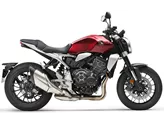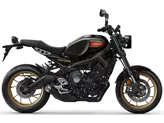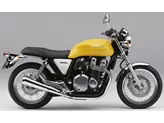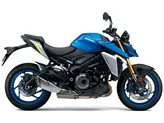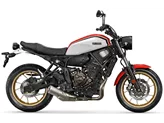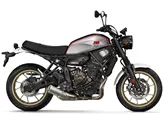Yamaha XSR900 2016 vs. Honda CB 1000 R 2019

Yamaha XSR900 2016

Honda CB 1000 R 2019
Overview - Yamaha XSR900 2016 vs Honda CB 1000 R 2019
The Yamaha XSR900 2016 and the Honda CB 1000 R 2019 are both naked bikes that offer powerful engines and advanced rider assistance systems. However, there are several differences between the two models that should be considered.
In terms of engine performance, the Honda CB 1000 R 2019 has a clear advantage. It is equipped with a 145 HP engine, compared to the Yamaha XSR900 2016's 115 HP engine. The Honda also has a higher torque of 104 Nm, while the Yamaha has 87.5 Nm. Additionally, the Honda CB 1000 R 2019 has four cylinders, while the Yamaha XSR900 2016 has three.
Both bikes have liquid cooling systems and upside-down telescopic forks for the front suspension. However, the Yamaha XSR900 2016 has a swing arm suspension for the rear, while the Honda CB 1000 R 2019 has a single swing arm suspension. Both models also have monoshock shock absorbers.

Yamaha XSR900 2016
In terms of chassis, the Yamaha XSR900 2016 has an aluminum frame with a twin tube design, while the Honda CB 1000 R 2019 has a steel frame with a backbone design. This difference in frame material and design may affect the overall weight and handling of the bikes.
Both bikes have double disk brakes at the front, but the Honda CB 1000 R 2019 has larger diameter disks (310 mm) compared to the Yamaha XSR900 2016 (298 mm). Both models also have ABS as standard.
In terms of dimensions and weights, the Honda CB 1000 R 2019 has a slightly larger wheelbase (1455 mm) compared to the Yamaha XSR900 2016 (1440 mm). The seat height of the Honda is also slightly higher at 830 mm, compared to the Yamaha's 815 mm. The Honda CB 1000 R 2019 is also heavier, with a kerb weight of 212 kg, compared to the Yamaha XSR900 2016's 191 kg. The Honda also has a larger fuel tank capacity of 16.2 liters, while the Yamaha has 14 liters.

Honda CB 1000 R 2019
In terms of strengths, the Yamaha XSR900 2016 is praised for its greedy engine, well-tuned riding modes, standard ABS and TC, authentic modern design, and clean workmanship. On the other hand, the Honda CB 1000 R 2019 is praised for its flawless responsiveness, rideability, good electronics package (including ABS, traction control, and riding modes), smooth and precise gearbox, and excellent functioning quickshifter.
In terms of weaknesses, the Yamaha XSR900 2016 is criticized for its hard chassis, uncomfortable seat, and speedblock design that is already seen on many other models. The Honda CB 1000 R 2019 is criticized for its black/white LCD display, which is not quite up to date and not easily readable in direct sunlight. Additionally, tall riders may have space problems with their knees at the tank.
Overall, the Honda CB 1000 R 2019 offers more power and advanced features compared to the Yamaha XSR900 2016. However, personal preferences and specific needs should be taken into consideration when choosing between the two models.
Technical Specifications Yamaha XSR900 2016 compared to Honda CB 1000 R 2019
Pros and Cons in comparison
Pros and Cons in comparison
Yamaha XSR900 2016

The XSR900 combines the performance of a sporty streetfighter with the look of a pleasing, cleanly finished retro naked bike. In doing so, the Japanese make use of their own history, which can be found bundled and without gaps in the archive of the design agency that has been working for Yamaha for 60 years. It adopts the virtues of the MT-09 and has mended some of its weaknesses. It rides more harmoniously, more controlled and, if desired, more relaxed. Only the comfort, and thus the rider, suffers from the tight chassis on bad roads. You have to be a little bit sensitive when it comes to a neo-classic.
Honda CB 1000 R 2019

The 1-litre version of the Neo Sport Cafe Racer shows that it doesn't always have to be the golden mean. In all honesty, it has to be said that the largest of all the representatives also feels the most "grown-up". The electronic equipment of the 1000 in the + version leaves almost nothing to be desired and the handling is extremely rider-friendly for this class. Playfully easy cornering with a well-tuned chassis, snappy brakes and low weight seem to be the recipe for success in terms of smoothness. In terms of performance, the CB1000R+ unfortunately has to make concessions. With 145 hp, the Honda is not a brute rocket, but it is all the more controllable for it. And 145 hp with a full tank of 213 kg is more than enough for maximum riding pleasure on country roads!
Price Comparison Avarage Market Price Yamaha XSR900 vs Honda CB 1000 R
There are a few key differences between a Yamaha XSR900 2016 and a Honda CB 1000 R 2019. In terms of price, the actual average price of a Honda CB 1000 R 2019 is about 53% higher. A Yamaha XSR900 2016 experiences a loss of 1,680 GBP in one year and 1,690 GBP in two years of ownership. This is offset by a loss of 980 GBP and 1,330 GBP for a Honda CB 1000 R 2019. Compared to Honda CB 1000 R 2019 there are less Yamaha XSR900 2016 bikes available on the 1000PS.de Marketplace, specifically 5 compared to 16. It takes less time to sell a Yamaha XSR900 with 77 days compared to 116 days for a Honda CB 1000 R. Since model year 2016 1000PS.de editors have written 30 reviews for the Yamaha XSR900 and 42 reviews for the Honda CB 1000 R since model year 2008. The first review for the Yamaha XSR900 was published on 25/11/2015 and now has more than 17,600 views. This compares to more than 10,400 views for the first review on Honda CB 1000 R published on 06/11/2007.







